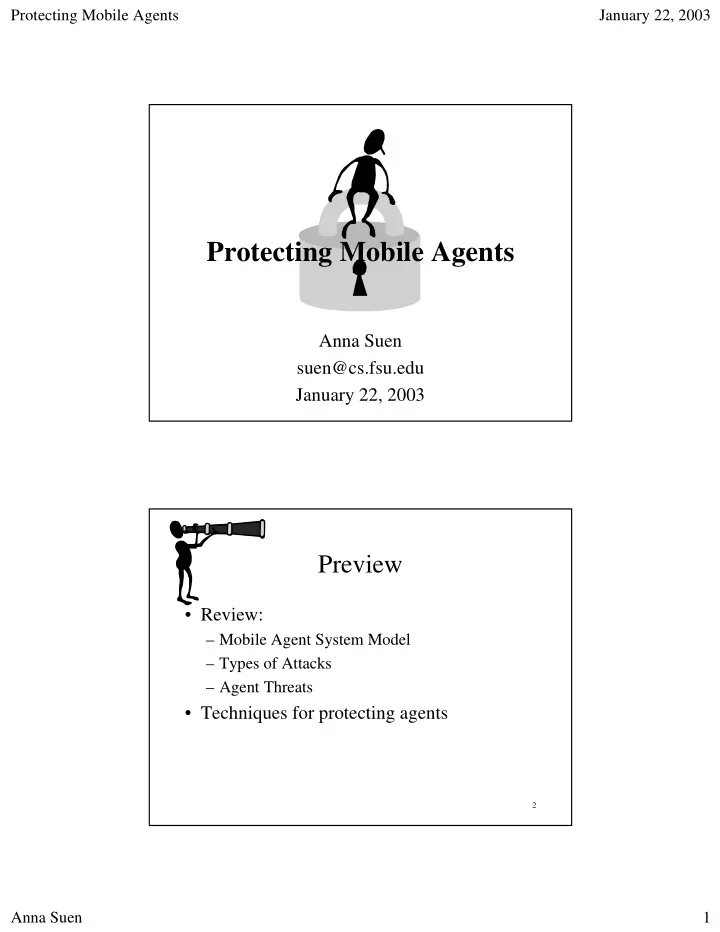

Protecting Mobile Agents January 22, 2003 Protecting Mobile Agents Anna Suen suen@cs.fsu.edu January 22, 2003 Preview • Review: – Mobile Agent System Model – Types of Attacks – Agent Threats • Techniques for protecting agents 2 Anna Suen 1
Protecting Mobile Agents January 22, 2003 Mobile Agent System Model • Agent – code and state info needed for some computation • Agent Platform – computational environment – Note: platform = server = host 3 Types of Attacks • Agent-to-Platform • Agent-to-Agent • Platform-to-Agent • Other-to-Agent Platform 4 Anna Suen 2
Protecting Mobile Agents January 22, 2003 Agent Threats • Masquerading • Denial of Service • Repudiation • Eavesdropping • Alteration 5 Prevention vs. Detection • prevention of tampering is difficult – agent completely susceptible to the platform • detection of tampering instead 6 Anna Suen 3
Protecting Mobile Agents January 22, 2003 agent Simple Techniques • Jumping Beans – agent always returns to secure central host before moving to next platform • IBM Aglets – trusted network • only receive agents that came from a trusted platform • These not agent systems with free-roaming agents 7 data Partial Result Encapsulation • encapsulate results at each platform visited for later verification • Sliding Encryption – agent encrypts data with public key at each platform – originator decrypts with private key 8 Anna Suen 4
Protecting Mobile Agents January 22, 2003 data Partial Result Authentication Code (PRAC) • agent and originator maintain or generate a list of secret keys • each server: – summarizes results in a message – uses the secret key to compute an authentication tag (MAC) on the data • agent/server destroys secret key – only originator has a copy of all the secret keys to verify results • message and MAC sent to originator – use to check integrity of data 9 data Karjoth, et al • improvement on PRAC • server creates an encapsulation that is linked to the result – hash chaining • chain of encapsulations binds each result to all previous results and the identity of the next platform to be visited 10 Anna Suen 5
Protecting Mobile Agents January 22, 2003 agent Mutual Itinerary Recording • have a cooperating agent record and track itinerary • sends to cooperating agent last platform, current platform, and next platform info – authenticated channel • agents avoid visiting platforms already visited by cooperating agent • can be extended to more than two cooperating agents 11 agent Replication and Voting • send multiple copies of the agent • a malicious platform may corrupt some of the agents • enough replicates to successfully complete its task 12 Anna Suen 6
Protecting Mobile Agents January 22, 2003 agent Execution Tracing • platforms maintain a non-repudiatable trace (log) of agent’s operations – send receipt message to designated recipient – execute agent and produce corresponding trace – send designated recipient • hash of final state • hash of execution trace – send final state to originator • if suspect tampering – ask for execution traces and receipts – simulate the agent execution and compare results with 13 traces and receipts agent Environmental Key Generation • allows agent to take predefined action when some environmental condition is true • when agent encounters an environmental condition a key is generated – use key to unlock executable code • environmental condition is hidden 14 Anna Suen 7
Protecting Mobile Agents January 22, 2003 agent Computing with Encrypted Functions • platform execute a program with an embedded function without revealing the original function 15 agent Obfuscated Code • scrambled code – no one can completely understand the function – cannot modify resulting code without detection 16 Anna Suen 8
Protecting Mobile Agents January 22, 2003 data Data Collection Protocol • shared key between originator and each server • each server computes an integrity proof value and integrates it into the overall integrity proof value – set hashing: method to hash together a set of data blocks in an order-independent fashion • agent returns to originator: – set of collected data – overall integrity proof value • originator verifies integrity of data with overall integrity proof value 17 Review • Partial Result Encapsulation • Mutual Itinerary Recording • Replication and Voting • Execution Tracing • Environmental Key Generation • Computing with Encrypted Functions • Obfuscated Code • Data Collection Protocol 18 Anna Suen 9
Protecting Mobile Agents January 22, 2003 Questions? 19 References • Wayne Jansen & Tom Karygiannis. "Mobile Agent Security." NIST Special Publication 800-19. September 1999. • G. Karjoth, N. Asokan, and C. Gulcu. "Protecting the Computation Results of Free-roaming Agents." Lecture Notes in Computer Science 1477, pgs 195- 207. 1998. • Sergio Loureiro, Refik Molva, and Alain Pannetrat. "Secure Data Collection with Updates." Electronic Commerce Research Journal. Vol 1, No 2. February/March 2001. • Giovanni Vigna. "Protecting Mobile Agents through Tracing." Proceedings of the 3 rd ECOOP Workshop on Mobile Object Systems. Jyvalskyla, Finland. June 1997. • Bennet S. Yee. "A Sanctuary for Mobile Agents." UC San Diego, Department of Computer Science and Engineering. April 28, 1997. 20 Anna Suen 10
Recommend
More recommend